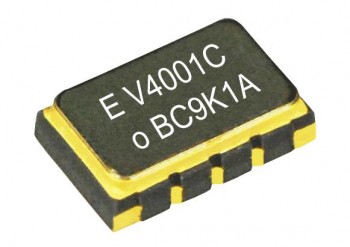Epson improves car navigation systems with new series of gyroscopic sensors

Samples of digital gyroscopic sensors in the XV4001 series (XV4001BC)
Photo by EPSON EUROPE ELECTRONICS GmbH
Seiko Epson Corporation (TSE: 6724, “Epson”) today began shipping samples of products in its new XV4001 series of high-precision gyroscopic sensors. These sensors, designed for car navigation systems, are available with either an SPI or I2C digital output interface.
Gyroscopic sensors are generally used in car navigation systems for pinpointing current position by sensing changes in vehicle travel direction and for dead reckoning in locations where GPS signals are lost, such as in tunnels. Users of analog-output quartz gyroscopic sensors have to convert those analog signals into digital signals, generally by using an external A/D converter. However, converting the output format involves signal line routing, peripheral circuitry, and other troublesome complications that place an extra engineering load on users. Users interested in lightening this load have been driving higher demand for gyroscopes with digital output interfaces.
Epson responded by commercializing the XV4001 series of gyroscopic sensors, which can be ordered with either a popular 3-wire and 4-wire SPI digital interface or an I2C digital interface. These highly accurate products combine small, stable, hammerhead-shaped QMEMS crystals with optimized Epson ICs. They also provide excellent temperature compensation, for better-than-ever stability and accuracy over changes in temperature. In addition, Epson further increased reliability by providing these gyroscopes with a new self-test function that senses irregularities.
The XV4001 series consists of four models, with different interface and package tilt angle combinations for different integrations. The XV4001BD (SPI interface) and XV4001BC (I2C interface) have a package tilt angle of 0 degrees. The XV4001KD (SPI interface) and XV4001KC (I2C interface) have a package tilt angle of 20 degrees.
“We are delighted to bring these products to market,” said Masayuki Kitamura, chief operating officer of Epson’s Microdevices Operations Division. “As a leader in crystal devices, Epson will continue to provide the kind of compact, accurate, stable products required in electronics and social infrastructure.”
For more information, please visit http://www.epson-electronics.de
News Categories
- » NEWS HOME
- » Automation & Robotics
- » Industry 4.0
- » Material Handling
- » Sensors
- » Quality & Testing
- » Machine Vision
- » Laser & Optics
- » Metalworking
- » Motion Control & Drives
- » Hydraulics & Pneumatics
- » Process Industry
- » Renewable Energy
- » Agriculture
- » Home & Office Furniture
- » Environmental Tech

